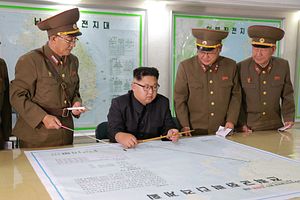Early on Wednesday morning, U.S. President Donald J. Trump took to Twitter to offer his latest comment on the ongoing war-of-words between North Korea and the United States. At 7:39 a.m., Trump tweeted the following:
Kim Jong Un of North Korea made a very wise and well reasoned decision. The alternative would have been both catastrophic and unacceptable!
The early morning release of this presidential tweet and its content suggested that Trump had concluded that North Korean leader Kim Jong-un had walked back a threat to fire missiles at the waters near Guam.
More concerning, the tweet hints at Trump’s possible belief that Kim’s “well reasoned” decision was a result of successful deterrence by the United States — presumably borne of Trump’s own threats of “fire and fury” last week for continued threats from North Korea.
While coverage of recent events may lead some to this conclusion, nothing could be further from the truth. Kim Jong-un was not deterred by anything the United States did and he did not back down, as some mainstream sources in the U.S. suggested.
A review of what North Korea has said over the past seven days through its state-run Korean Central News Agency (KCNA) makes this clear.
First of all, the ongoing episode concerning a threat to Guam from North Korean Hwasong-12 intermediate-range ballistic missiles began last week, on August 8, when KCNA featured an article by a spokesman for the Korean People’s Army Strategic Rocket Force, which outlined the much-discussed plan to strike Guam.
The statement noted that the “grave situation” of the United States basing strategic bombers at Guam, including B-1B Lancers, which North Korea incorrectly perceives to nuclear-capable, “requires the KPA to closely watch Guam, the outpost and beachhead for invading [North Korea].”
In another article, Kim Rak-gyom, the chief of the KPA’s Strategic Rocket Force, outlined the plan, including a specific flight trajectory for the Hwasong-12s, which would conduct an “enveloping fire” of Guam, bracketing the island with four missiles. He noted that the plan would be presented to Kim Jong-un in “mid-August.”
Instead of North Korea backing down from any of the above, precisely what Kim Rak-gyom promised occurred on August 15. Kim Jong-un inspected the Korean People’s Army Strategic Force Command, reviewing the plan to strike Guam along with Kim Rak-gyom. Pyongyang released images of this, showcasing a map outlining a flight path for the missiles from the coastal city of Sinpo in North Korea to Guam.
Put simply: what Kim Rak-gyom committed to last week happened; nothing more, nothing less. Kim Jong-un reviewed the plan to strike Guam. What was never promised in any statement was a decision or a deadline for a decision by Kim to strike Guam itself. What is left open is the possibility that after the August 15 review, Kim Jong-un may at any point make the decision to move forward with the salvo launch plan.
Much of this subtlety was lost in mainstream U.S. and Western media coverage of this episode. Above all, the KCNA statements included an important condition for any decision to move forward with the plan.
Specifically, per multiple KCNA statements over the last week, North Korea is looking to give the United States an opportunity to cease flights of B-1B Lancer non-nuclear-capable bombers to the Korean peninsula and, perhaps more significantly, modify the upcoming Ulchi-Freedom Guardian U.S.-South Korean bilateral exercises to avoid a strike near Guam.
The ongoing episode over the prospective Guam strikes has certainly not yet come to a close. Most importantly, conversely to Trump’s thinking, Kim Jong-un has not made any “well reasoned decision” to back down. North Korean credibility hasn’t been put on the line over any “red line” declaration just yet.
In the North Korean view, Kim is free to take no action on this Guam launch plan, retaining it as an ace up his sleeve. However, if the United States chooses to take no action on ceasing B-1B flights or modifying the upcoming military exercises, the plan may yet proceed.
None of this is an academic exercise. While parsing KCNA statements may not seem important, the incorrect view in the United States that North Korea was successfully deterred from undertaking a highly provocative action when nothing of the sort occurred can lead to destabilizing escalation built on poor assumptions.
The “Guam strike” episode with North Korea thus continues — at least until August 21, when the Ulchi-Freedom Guardian exercises are slated to begin. By not taking a decision to authorize launch on August 15, after being briefed by Kim Rak-gyom, Kim Jong-un did signal some deescalatory intent given the ongoing war of words, but none of this means that the threat is off the table or that North Korea has backed down.

































